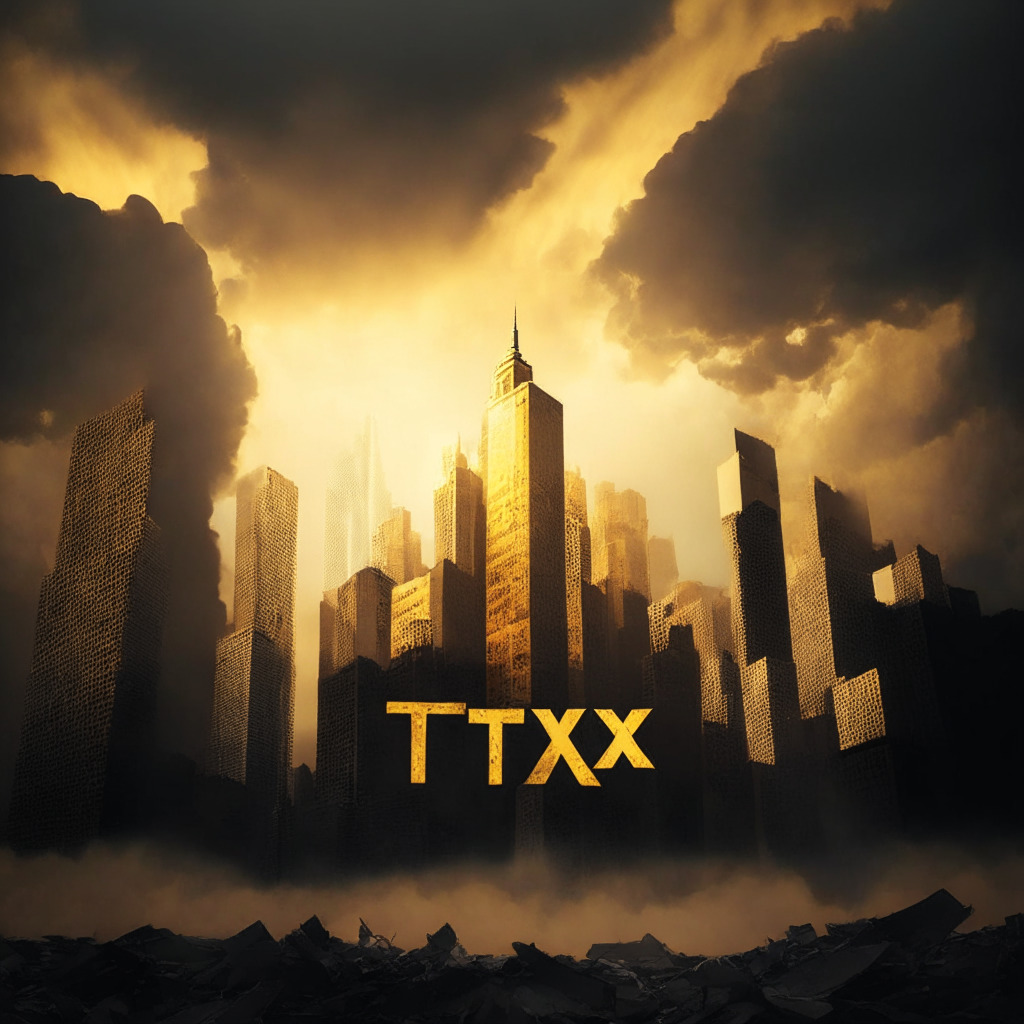“The mounting US consumer debt could provide an advantage for Bitcoin’s price amid an evolving economic landscape. While consumers expend the surplus savings built up during the pandemic, threats of inflation loom. Amid these uncertainties, cryptocurrency, particularly Bitcoin, may see influences in its trajectory.”
Search Results for: jpmorgan
Cryptocurrency Disruption: Diving Deeper into Futures, Influences and Legal Ambiguities
The report by JPMorgan suggests the open interest in Bitcoin futures at the CME is nearing the end of its cycle, indicating an optimistic approach to the near-term impact on crypto markets with a limited downside. The SEC’s ongoing Ripple case, market dynamics, and tech assets adjustments are influencing market fluctuations. The future course for digital assets will be shaped by macroeconomics, regulatory developments, and industry-specific events.
The Digital Canvas Mourns While Crypto Regulation Tightens: A Week in Blockchain Review
“Cheems, the Shiba Inu who inspired countless memes and an NFT collection, sadly passed away. Governmental involvement in crypto continues, with Kenya probing Worldcoin and Somalia banning crypto-friendly messaging app Telegram. Individual Bitcoin miner successfully mined block 803,821, revealing competitiveness against mining pools.”
Crypto Markets Calm as Storm Brews Behind the Scenes: Failures, Diversification, and Anticipated Swings
Major cryptocurrencies showed a stable trend, despite turbulence like the slump of SHIB partially due to its unsuccessful Ethereum layer 2 network, Shibarium. Ethereum co-founder, Vitalik Buterin, transferred $1 million worth of cryptocurrency whilst facing a market downturn. This turbulent environment led to a strategic shift for bitcoin miners into new business areas.
Exploring the New Horizons: How Crypto Miners Diversify Revenue Streams into AI Market
“Bitcoin and Ether miners are branching into new business areas including high performance computing services for the artificial intelligence industry, seeking to diversify revenue and reduce crypto reliance. This follows the Ethereum blockchain Merge, leaving a surplus of GPUs on the secondary market, used for gaming, rendering services and mining other cryptocurrencies.”
Revolutionizing Finance: Blockchain and the Future of Asset Tokenization
“Blockchain technology has the potential to revolutionize financial assets trading by tokenizing real world assets. This process can enhance liquidity, reduce costs, and improve risk management. However, with the goal of benefiting economic growth and SMEs, a more standardized tokenization process must also accurately represent financial obligations, liabilities, and cash flows.”
Decentralized Finance: Far from Dead or a Doomed Experiment?
“Despite setbacks and criticisms, such as the recent Curve Finance controversy, the DeFi sector is far from ‘dead.’ It’s actually seeing significant interest from corporate stalwarts like Mastercard, Visa, and BlackRock, all harnessing its efficiency-enhancing capabilities. Decentralized finance technology promises transparency, efficiency, disintermediation, and self-custody, indicating the sector’s potential for long-term growth.”
Coinbase’s Earnings Exceed Expectations: A Deep Dive into Analysts’ Mixed Reactions
Cryptocurrency exchange Coinbase’s recent earnings surpassed expectations but major institutions raised concerns about its long-term growth potential. Issues include a lack of sustainable everyday utility value in the crypto industry, concerns about revenue diversification, and reduced transaction volumes. Despite this, Coinbase remains confident about its prospects.
Navigating the Turbulence: CFO Change, Rising Revenues and Legal Battles in Digital Currency Group
Digital Currency Group (DCG) has appointed Mark Shifke as the new CFO, following the departure of former CFO Michael Kraines. DCG has reported Q2 revenues of $216 million but also consolidated quarterly losses of $79 million. Ongoing negotiations to settle claims for defunct subsidiary Genesis Global Holdco and a lawsuit from creditor Gemini Trust hint at turbulent times for DCG.
The Inevitable Clash: Central Bank Digital Currencies Versus Private Banks
“Central bank digital currencies (CBDCs) aim to regain monetary control by utilizing the blockchain, posing a threat to private financial institutions. Amid this, 93% of central banks are conducting CBDC research, predicting 24 CBDCs in circulation by 2030.”
Unmasking Bitcoin: Environmental Villain or Climate Change Combatant?
This excerpt spotlights a less-known aspect of bitcoin mining: its tendency to exploit the cheapest available electricity, regardless of location. It also notes how bitcoin can incentivize cleaner, more efficient energy practices through waste mitigation and electrification of heating, potentially creating a future of environmentally friendly energy consumption.
Unveiling FedNow: Monetary Revolution or Strategic Response to Blockchain?
“The ‘FedNow’ service, launched by the U.S. Federal Reserve, aims to make financial transactions swifter. However, its inception may also signify a move towards a Central Bank Digital Currency (CBDC), potentially merging traditional banking with emerging blockchain technologies.”
Navigating the Crypto Course amidst the United States’ Macroeconomic Shocks
The crypto market closely watches upcoming U.S macroeconomic events. Despite a favorable swing in the CPI, the US central bank sticks to hiking the interest rate. The hawkish financial stance affects crypto prices, increasing investor concerns about central bank overreach. Other significant influences include retail sales, industrial productivity, home sales, and weekly jobless claims data.
Navigating Crypto Terrain: From BNB Shorting to 1inch Rally and Bitcoin Halving Implications
“BNB perpetual futures signal a price drop with increased shorting, as 1INCH value surges by over 58%. Bitcoin’s upcoming halving event in 2024 is predicted to challenge miner revenues. Meanwhile, CELO’s growth aligns with cLabs’ transition proposal, showcasing the crypto sphere’s dynamism and unpredictability.”
Bitcoin ETFs – A False Dawn or a Beacon of Hope? Be Ready for the Crypto Rollercoaster
The recent dip in Bitcoin price followed a wave of ETF applications in the US which failed to shift market sentiment as anticipated. JPMorgan’s analysis suggests lack of transformative potential in the US ETF landscape. Despite this, ‘whales’ have accumulated an additional equivalent of $2.15 billion in Bitcoin, opposing the JPMorgan analysis. Understanding volatility and risk in digital assets is crucial before making financial decisions.
Free Money Allure in Altcoins: A Boon or Bane Amidst Argentina’s Economic Strife?
“Analyst Marcel Pechman states that amid Argentina’s escalating inflation, altcoins and airdrops attract investors despite the risks. He warns against promises of free money and highlights Bitcoin’s potential, driven by the devaluation of the US dollar. Pechman also discusses U.S. Bitcoin ETF approval, which may intensify trading activity, although opinions on its market impact vary.”
Pondering the Impact: Will Bitcoin ETF Approval Alter the Crypto Game?
A JPMorgan report suggests that the approval of a spot Bitcoin ETF may not drastically change the game as expected. Evidence from Europe and Canada, where such ETFs exist but failed to attract substantial investor interest, supports this claim. Nonetheless, some believe an approved Bitcoin ETF could increase Bitcoin’s liquidity and catalyze investor migration.
U.S. Spot Bitcoin ETF: Regulatory Milestone or Investor Attraction Dampener?
“The U.S. SEC’s potential approval of a spot bitcoin ETF may not significantly influence crypto markets, according to investment banking giant JPMorgan. Their report suggests the lack of interest in similar ETFs in Europe and Canada implies that even though a spot bitcoin ETF offers a streamlined, secure cryptocurrency investment method, it fails to attract widespread investor attention.”
U.S Bitcoin Mining Stocks’ Remarkable Comeback: Resilience Amidst Harsh Crypto Winter
Bitcoin mining stocks in the U.S have witnessed a remarkable recovery in 2023, fueled by the strong performance of Bitcoin and institutional exchange-traded-fund (ETF) filings by financial giants. Additionally, resilient miners with minimal costs have profited when Bitcoin prices surpass production costs. However, high-debt miners struggle in this harsh landscape.
Unleashing AI in Crypto Trading: A Leap of Progress or a Pandora’s Box?
Brett Harrison, former FTX.US president, has launched Architect, a new trading platform harnessing AI for trading strategies. The platform could equip traders to buy cryptocurrencies like Bitcoin on Coinbase when the market price drops, while also fostering an understanding of the technology. However, the integration of AI into trading raises questions about potential complications.
The Future of Tokenization: CBDCs, Decentralization, and Global Monetary Landscape
The IMF and BIS published reports discussing the future of the monetary system and the potential impact of crypto and central bank digital currencies (CBDCs) on tokenization. Tokenization represents claims digitally on a programmable platform, integrating records of underlying assets with their transfer rules and logic. The reports emphasize tokenized CBDCs’ role in maintaining settlement stability and “singleness of money.”
FTX 2.0 Revival: Crypto Exchange’s Restructuring Attracts Big Players and Controversy
FTX Debtors plan to revive the troubled crypto exchange FTX through a bankruptcy restructuring, with notable 363 Sales Parties like Nasdaq, Ripple Labs, and BlackRock expressing interest. FTX 2.0 aims to relaunch amidst traditional financial firms’ growing involvement in the cryptocurrency industry.
Crypto World Update: Scandals, Legal Battles, Innovations, and Safety Concerns
This week in crypto, deception and legal battles intertwined with ambitious innovations. Key highlights include Crypto.com’s internal teams trading tokens for profit, Valkyrie Funds filing a Bitcoin ETF application, and global governments exploring digital currency regulations. Safety remains crucial as crypto crime and hacks persist.
JPM Coin Expands to Euro Transactions: Impact on Corporate Clients and Future Prospects
JPMorgan has expanded its JPM Coin blockchain payment service to include euro-denominated transactions for corporate clients, enabling 24/7 transfers between accounts globally. This provides an alternative to traditional methods and can lead to more effective liquidity management, particularly for major banks exploring blockchain technology for improved processes.
Bitcoin Boom: Time for Caution or Full Steam Ahead? Analyzing Market Sentiment and Crypto Stability
Bitcoin has witnessed a 20% price increase, pushing the Matrixport’s Bitcoin Greed & Fear Index to 93%. Meanwhile, crypto custody company Prime Trust faces a shortfall in customer funds, and JPMorgan expands its blockchain-based JPM Coin for euro payments, with Siemens making the first euro transaction.
JPM Coin Expands to Euro Payments: Can Blockchain Rival Traditional Transaction Methods?
JPMorgan expands its settlement token JPM Coin for euro-denominated payments, with German tech giant Siemens executing the first euro payment. JPM Coin has processed over $300 billion in transactions since its 2019 induction, signifying significant blockchain integration within a traditional financial institution, though it still faces challenges such as scalability and industry skepticism.
JPM Coin Euro Payments: Blockchain Revolutionizing Traditional Banking Services
JPMorgan expands its blockchain-based payment system, JPM Coin, introducing euro-denominated payments for corporate clients. This move brings blockchain technology into traditional banking services, offering instant transactions, 24/7 transfers, reduced costs, and increased interest income on deposits, while challenging conventional banking methods.
The Future of Bitcoin Mining: Low Electricity Costs, Sustainable Energy, and Profitability
A recent JPMorgan report emphasizes the importance of low electricity costs and sustainable energy for the survival of BTC miners in an increasingly competitive market. Lower electricity costs help maintain profitability amidst surging hashrate levels, while utilizing renewable energy sources benefits the environment and industry competitiveness.
From Bankruptcy to Galaxy Digital: Examining Leon Marshall’s Crypto Journey and Industry Resilience
Crypto veteran Leon Marshall joins Galaxy Digital as global head of sales, bringing valuable experience from Gnosis, CryptoCompare, UBS, and JPMorgan Chase. Despite recent challenges, Marshall remains optimistic about the digital asset industry’s future and Galaxy’s role within.
Ripple’s Singapore Milestone: Growing Influence and Crypto Regulation Balancing Act
Ripple received in-principle approval for the Major Payments Institution License in Singapore, allowing it to offer regulated digital payment token products and services. This move expands the use of Ripple’s On-Demand Liquidity service and reinforces its commitment to engaging with regulators worldwide.
Embracing Purpose Bound Money: Revolutionizing Finance or Inviting Scrutiny?
Singapore proposes a common standard for digital currencies, including stablecoins, tokenized bank deposits, and CBDCs, with contributions from major banks, investors, and global leaders. The Monetary Authority of Singapore’s whitepaper on Purpose Bound Money (PBM) aims to revolutionize the financial landscape by allowing senders to specify conditions and improving settlement efficiency, merchant acquisition, and user experience. However, increased regulatory scrutiny is a challenge to be considered in this rapidly growing digital financial landscape.
Ethereum Price Rally: Analyzing the Resistance Barrier and Potential Breakout Prospects
The Ethereum price recently experienced an 8.5% surge after encountering a crucial support level, reaching a resistance zone of $1775-$1765. However, selling pressure halted the rising momentum, suggesting possible consolidation before a significant recovery rally. JPMorgan recently backed Ethereum, despite some disagreements within the crypto community.






























